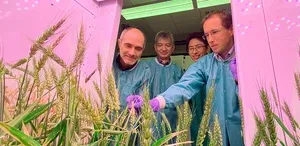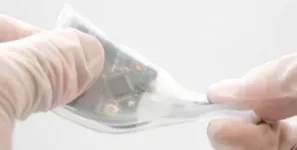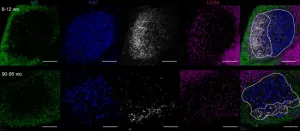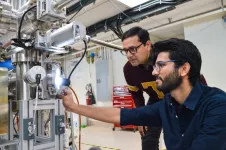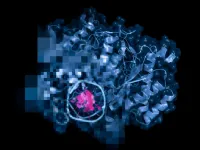(Press-News.org) Researchers have cloned the wheat rust resistance genes Lr9 and Sr43 and identified that they encode unusual kinase fusion proteins[1][2]. Their research will enable new options for addressing resistance to disease in bread wheat.
Each year about 20 percent of global wheat production is lost to pests and disease, the equivalent of 3,500 grain ships. Breeding resistant cultivars is one of the most economical and environmentally friendly ways to address the problem.
The wild relatives of wheat provide a reservoir of genetic diversity for crop improvement. The Lr9 leaf rust resistance gene, for example, was originally identified in a wild goatgrass (Aegilops umbellulata). In a pioneering experiment conducted in the 1950s, Dr Ernest Sears succeeded in transferring a tiny Lr9-carrying segment of an Aegilops chromosome into bread wheat, demonstrating that it is possible to stably cross small chromosome segments from distant wild relatives.
Nearly 40 percent of the resistance genes found in bread wheat today have been crossed into wheat from wild relatives over the last 60 years. Wheat cultivars carrying Lr9 were released in the late 1960s, and Lr9 is still effective in many wheat growing areas. However, this type of breeding can lead to co-introduction of unfavorable versions of other genes from the wild relative, known as “linkage drag.”
KAUST researcher Yajun Wang used long-read sequencing to sequence the genomes of an Lr9-containing bread wheat cultivar and Ae. umbellulata. Comparison of the two genomes allowed the full reconstruction of this historic translocation. “We found that Lr9 had been introduced into wheat along with about 536 other genes from Aegilops umbellulata. Moreover, the process led to the deletion of a small fragment of the wheat genome containing 87 genes,” says Wang.
Similar to Lr9, the stem rust resistance gene Sr43 came from the wild tall wheatgrass (Thinopyrum elongatum).
Two teams led by Simon Krattinger and Brande Wulff cloned Lr9 and Sr43, respectively, by generating mutants and comparing their sequence to the parent genomes.
“The cloned genes can now be used to engineer bread wheat lines without linkage drag. More importantly, the genes can be combined with other cloned rust resistance genes into multigene stacks to create lines with superior and more durable resistance,” says Guotai Yu, lead researcher on the Sr43 project.
To clone Lr9, Wang developed a novel method called MutIsoSeq based on sequencing mRNA rather than genomic DNA. It combines long-read sequencing of mRNA from wild-type parental lines and short-read mRNA sequencing of mutant plants to identify candidate genes. Compared to other gene-cloning methods based on DNA sequencing, MutIsoSeq allows cheaper and faster cloning of causal genes without tedious genetic mapping, and the method can be easily applied in any basic molecular biology lab.
The cloning of Lr9 and Sr43 also revealed that the genes encode unusual kinase fusion proteins. Wheat kinases have recently emerged as a prominent new player involved in disease resistance in wheat and barley. The researchers combined large-scale mutational analysis and AlphaFold protein modeling to interpret the protein function.
“A kinase is a common enzyme that plays important roles in many cellular processes in both plants and animals, including in immunity,” says Krattinger.
“Pathogens secrete proteins that sabotage host processes, subverting the host and causing disease. Our work suggests that the fusion of these proteins to kinases may allow the host to more easily detect the presence of pathogens and trigger defense responses,” he adds.
A peculiar feature of the Sr43 gene is that it does not provide good resistance at elevated temperatures.
“Having cloned Sr43, we can now start to unravel the molecular mechanism of its temperature sensitivity. This may allow us to engineer a heat resistant version that would be better adapted to climate change,” says Wulff.
END
Uncovering new mechanisms for wheat rust resistance
2023-05-22
ELSE PRESS RELEASES FROM THIS DATE:
Importance of neuroscientific evidence for rape trials
2023-05-22
The law should take into consideration neuroscientific evidence that suggests fear and threat can cause victims to become ‘frozen’ in cases of rape or sexual assault, argue UCL experts.
In a comment article, published in Nature Human Behaviour, Professor Patrick Haggard and former UCL undergraduate, Ebani Dhawan, state that victims of sexual assault are often blamed for not fighting or fleeing their attackers.
Thirty per cent of women are thought to experience sexual assault or rape in their lifetime. And, of those who have attended an emergency clinic, 70% reported being “frozen” during ...
Communities should reconsider walking away from curbside recycling, study shows
2023-05-22
Curbside recycling can compensate for the greenhouse gas emissions from garbage destined for landfills, says a new study that encourages towns and cities to continue offering recycling services to meet their climate goals.
The study’s authors took a deep dive into the economic and environmental value of community recycling efforts and compared it to the value of other climate change mitigation practices. They concluded that recycling provides a return on investment similar to or better than environmentally friendly strategies like transitioning to electric vehicles or purchasing green power, which is electricity from clean, renewable energy sources.
“Eliminating ...
A commonly used tool is suboptimal in predicting osteoporosis fracture risk in younger post-menopausal women
2023-05-22
FINDINGS
The commonly used Fracture Risk Assessment Tool (FRAX), which includes self-identified race and ethnicity information, and the Osteoporosis Self-Assessment Tool (OST), which does not, had suboptimal performance in determining major osteoporotic fracture risk across racial/ethnic categories in younger postmenopausal women. But OST was excellent for identifying who had osteoporosis within each racial/ethnic category.
BACKGROUND
The researchers sought to compare the ability of FRAX and OST ...
Prevalence of mental health diagnoses in children and adolescents before, during pandemic
2023-05-22
About The Study: The results of this cross-sectional study suggest that trends in mental health diagnoses among children and adolescents in the U.S. differed greatly by age and sex over the course of the COVID-19 pandemic. Female youth, especially female adolescents, represented the most vulnerable population with regard to marked increases in the prevalence of mental health diagnoses during the pandemic, the most pronounced being the prevalence of eating disorders.
Authors: Loreen Straub, M.D., M.S., of Brigham and Women’s Hospital and Harvard ...
Safety of Pfizer-BioNTech COVID-19 vaccine in children ages 5 to 17
2023-05-22
About The Study: Among 20 health outcomes that were monitored in near real time in this study including more than 3 million children ages 5 to 17 who received the Pfizer-BioNTech COVID-19 vaccine, a safety signal was identified for only myocarditis or pericarditis. Consistent with other published reports, these results provide additional evidence that COVID-19 vaccines are safe in children.
Authors: Steven A. Anderson, Ph.D., M.P.P., of the Food and Drug Administration in Silver Spring, ...
HPV transmission, persistence in pregnant women and neonates
2023-05-22
About The Study: In this study of 1,050 pregnant women and their neonates, vaginal human papillomavirus (HPV) was frequently detected in pregnant women. Perinatal transmission was infrequent, and in this cohort, no infection detected at birth persisted at six months. Although HPV was detected in placentas, it remains difficult to differentiate contamination versus true infection.
Authors: Helen Trottier, M.Sc., Ph.D., of the Universite de Montreal in Montreal, is the corresponding author.
To ...
A giant leap forward in wireless ultrasound monitoring for subjects in motion
2023-05-22
A team of engineers at the University of California San Diego has developed the first fully integrated wearable ultrasound system for deep-tissue monitoring, including for subjects on the go. It facilitates potentially life-saving cardiovascular monitoring and marks a major breakthrough for one of the world’s leading wearable ultrasound labs. The paper, “A fully integrated wearable ultrasound system to monitor deep tissues in moving subjects,” is published in the May 22, 2023 issue of Nature Biotechnology.
“This project gives a complete solution to wearable ultrasound technology—not ...
'Lost' immune cells partly to blame for reduced vaccine response in older people
2023-05-22
Understanding the ways our immune response changes as we age holds the key to designing better vaccines and boosting protection for people most at risk. Research published by Dr Michelle Linterman and her group today in Nature Immunology has explained that the organisation of the germinal centre, which is vital to the generation of longer-lived protection following vaccination, is altered in ageing. By demonstrating that these age-related changes can be reversed in mice, the research sets the foundation for interventions that bolster an effective vaccine response.
After a vaccination ...
Stretching metals at the atomic level allows researchers to create important materials for quantum, electronic, and spintronic applications
2023-05-22
A University of Minnesota Twin Cities-led team has developed a first-of-its-kind, breakthrough method that makes it easier to create high-quality metal oxide thin films out of “stubborn” metals that have historically been difficult to synthesize in an atomically precise manner. This research paves the way for scientists to develop better materials for various next-generation applications including quantum computing, microelectronics, sensors, and energy catalysis.
The researchers’ paper is published in Nature Nanotechnology, ...
AI predicts the function of enzymes
2023-05-22
Enzymes are the molecule factories in biological cells. However, which basic molecular building blocks they use to assemble target molecules is often unknown and difficult to measure. An international team including bioinformaticians from Heinrich Heine University Düsseldorf (HHU) has now taken an important step forward in this regard: Their AI method predicts with a high degree of accuracy whether an enzyme can work with a specific substrate. They now present their results in the scientific journal Nature Communications.
Enzymes are important biocatalysts in all living cells: They facilitate chemical reactions, through which all molecules ...

